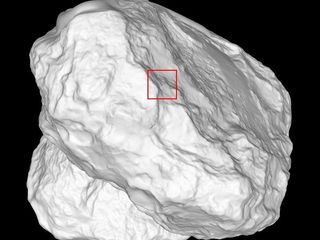
A European spacecraft has captured a photo of its own shadow on the comet it's studying from orbit.
The European Space Agency's Rosetta probe took the picture during a close flyby of Comet 67P/Churyumov-Gerasimenko on Feb. 14, when the sun, spacecraft and comet were all neatly aligned. This geometry gave Rosetta team members an interesting view of the comet's surface, since features on the icy body cast virtually no shadows of their own.
"Images taken from this viewpoint are of high scientific value," Holger Sierks of the Max Planck Institute for Solar System Research (MPS) in Germany, principal investigator for Rosetta's Optical, Spectroscopic and Infrared Remote Imaging System (OSIRIS), said in a statement. "This kind of view is key for the study of grain sizes." [Photos: Europe's Rosetta Comet Mission in Pictures]

OSIRIS captured the image, which was released Tuesday (March 3), as Rosetta flew just 3.7 miles (6 kilometers) from Comet 67P's surface, resulting in a resolution of 4.3 inches (11 centimeters) per pixel. It's the sharpest view of 67P from Rosetta except for pictures snapped by the mission's Philae lander during its descent to the comet's surface on Nov. 12, 2014, MPS representatives said.
The Rosetta spacecraft measures about 6.6 feet by 105 feet (2 by 32 meters) with its large solar arrays extended. But the probe's shadow on the comet's surface is considerably larger, about 66 feet by 164 feet (20 by 50 m), as a result of the "penumbra effect."
"Such penumbras occur when an object is illuminated by more than one light source, or an extended one like the sun," MPS representatives wrote in the statement.

"In both cases, light reaches the object from different directions, leading to a dark core shadow where the object blocks the entire light source and an adjacent penumbra where only part of the light source is concealed," they added. "Considering the distance between Rosetta and the comet's surface, the penumbra effect leads to a shadow both 20 meters longer and wider than Rosetta's dimensions."
Get the Space.com Newsletter
Breaking space news, the latest updates on rocket launches, skywatching events and more!
The Rosetta mission launched in March 2004 and arrived at Comet 67P in August 2014, becoming the first probe ever to orbit one of these icy bodies. Philae separated from the orbiting mothership and landed on the comet's surface on Nov. 12, bouncing twice before coming to a stop in a shadowed spot next to a cliff.
Philae went into hibernation a few days after its historic touchdown, but mission officials have voiced optimism that the lander may soon receive enough solar energy to wake up and resume working.
The Rosetta mothership continues to study 67P from orbit, and should keep doing so through at least the end of this year. The main goal of the mission is to learn more about the structure and composition of comets, and thereby gain insights about the solar system's early days.
Follow Mike Wall on Twitter @michaeldwall and Google+. Follow us @Spacedotcom, Facebook or Google+. Originally published on Space.com.
Join our Space Forums to keep talking space on the latest missions, night sky and more! And if you have a news tip, correction or comment, let us know at: community@space.com.

Michael Wall is a Senior Space Writer with Space.com and joined the team in 2010. He primarily covers exoplanets, spaceflight and military space, but has been known to dabble in the space art beat. His book about the search for alien life, "Out There," was published on Nov. 13, 2018. Before becoming a science writer, Michael worked as a herpetologist and wildlife biologist. He has a Ph.D. in evolutionary biology from the University of Sydney, Australia, a bachelor's degree from the University of Arizona, and a graduate certificate in science writing from the University of California, Santa Cruz. To find out what his latest project is, you can follow Michael on Twitter.
